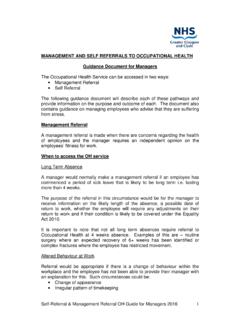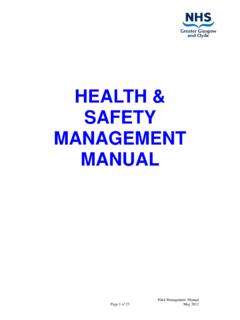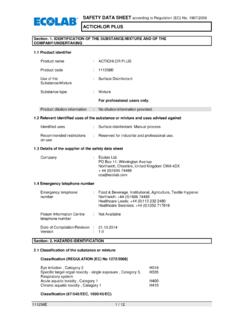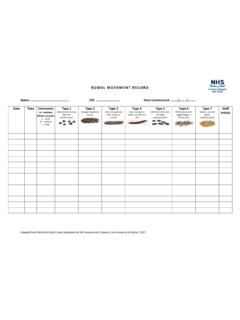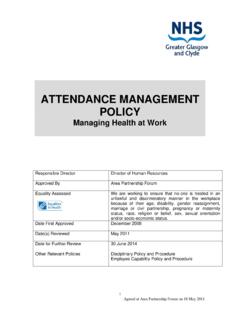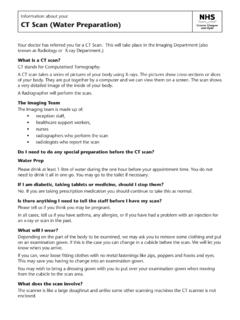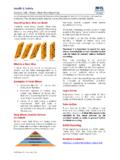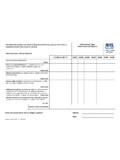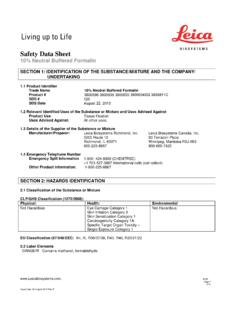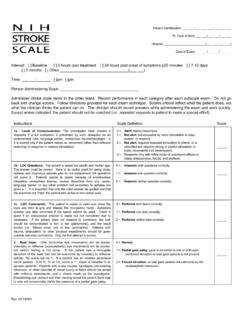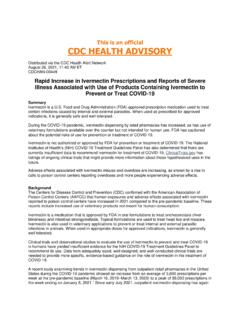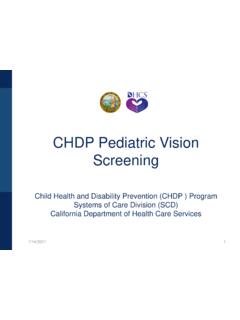Transcription of Best Practice Guidelines Visual Impairment
1 Best Practice Guidelines Visual Impairment CONTENTS Page No Executive Summary 4 1. Introduction 7 2. Background 8 3. Legal Responsibilities Making Adjustments and Taking Reasonable Steps in an Organisation 10 4. General Information Loss of Sight and blindness Registered Blind and Partially Sighted Barriers To Healthcare for People Who are Visually Impaired Aids/Equipment 11 5. Consultation Events Methodology User Feedback from Consultation Events 20 6. Current Practice : Acute Division Patient Support Services Assessment of Communication Needs Accessible Information Policy Pharmacy and Medication Assistance Dogs Wayfinding and Access Staff Training 27 7. Gaps and Priorities Access: Information and Buildings Communication Medication Management Support and Equipment Recommendations and Priorities Role of NHSGGC Staff 34 8.
2 Conclusion 39 References Useful Telephone Numbers, Addresses and Websites August 2012 Page 2 Acknowledgements NHS Greater Glasgow and Clyde (NHSGGC) would like to thank the Royal National Institute of Blind People Scotland (RNIB Scotland) and Visibility for their assistance in developing these Best Practice Guidelines . The organisation s thanks are extended to all who have contributed to the development of these Guidelines : John Legg, Director; Clair Henderson, Senior Research Officer; James Adams, Policy Manager; Clare Jewell, Service Development Officer from RNIB Scotland; Shelagh Palmer, Health Co-ordinator; Celia Traynor, Jamie Bruce and Heather Campbell, Patient Support Workers from Visibility; Deborah MacMillan and Iain Cooper service user and member of the Better Access to Health (BATH) Group.
3 Finally NHSGGC is grateful for the contributions from all who took part in the two consultation events which helped to inform these Best Practice Guidelines . Executive Summary Background The purpose of this document is to develop a set of Best Practice Guidelines for all NHS Greater Glasgow and Clyde (NHSGGC) staff. They have been developed to help improve communication for patients, visitors, carers and other key stakeholders with sensory Impairment . They outline what the organisation needs to address in order to meet the needs of visually impaired people to promote safe effective Practice . Deaf, hearing impaired and Deafblind Best Practice Guidelines have been developed as a separate document, available at There are almost around 188,000 people living with sight problems in Scotland29.
4 Many of these people are elderly and 90% of blind and partially sighted people are over 60. It is estimated that 1 in 8 of the general population has some degree of sight loss1. However, it is well documented that blind and partially sighted registration data underestimates the number of people living with a significant Visual impairment2. By 2031, the number of people with significant sight problems in Scotland is set to double to around 400,000 29. Approximately 40% of the population will be over 60 and, therefore, the problems associated with Visual Impairment will increase3. In addition, there is a growing incidence in key underlying causes of sight loss, such as obesity and statistics have considerable implications for NHSGGC. In NHSGGC there are about 20,000 people with a Visual Impairment using the full range of health and care services and it is important that they have the best possible experience of and access to services and support.
5 This document examines disability legislation with regard to access to services by disabled people and makes recommendations for reasonable adjustments for disabled people to enable equitable access to services for all. This organisation is committed to ensuring equality issues are addressed under the NHSGGC Equality Scheme 2010-2013. NHSGGC promotes inequality sensitive Practice in all of its services, covering all protected characteristics; race, disability, gender, sexual orientation, religion, age socioeconomic status as well as social class7. August 2012 Page 4 Process NHSGGC has a duty of care for everyone who requests or requires its services. The organisation is committed to improving services for visually impaired people through evidence based Practice and partnership working.
6 As a result, these Guidelines have been developed in partnership with the Royal National Institute of Blind People Scotland (RNIB Scotland) and Visibility to highlight best Practice . As part of this process two consultation events were held and the following areas were explored. Issues relating to accessing NHSGGC services Issues relating to communication when using NHSGGC services Issues relating to support and equipment Main findings Feedback from consultation has highlighted four main areas which cause barriers to access: Staff attitudes towards people who are visually impaired Staff awareness in relation to the needs of people who are sensory impaired Lack of patient information in different formats Signage and wayfinding Recommendations: Priorities In response to these findings an Action Plan has been developed to take forward the following priorities.
7 Implement Visual Impairment Best Practice Guidelines Additional focus and support in relation to good Practice in priority areas Ophthalmology Clinics and Wards or Development of best Practice with regard to all aspects of Visual Impairment in priority areas Access to additional Sensory Impairment training for priority staff staff in Ophthalmology Clinics and Wards Training for medical staff in relation to registering people with Visual Impairment requires urgent attention August 2012 Page 5 There needs to be an additional focus building on the availability of the existing patient support service at the Gartnavel and the Victoria Infirmary Improve staff knowledge and awareness of equipment available to help people who are visually impaired. Review of support services provided by voluntary organisations and increase in provision to ensure equitable access to these services across NHSGGC.
8 Raising awareness of staff responsibility in relation to providing patient information in different formats in line with he Accessible Information Policy (AIP) Ensure the AIP is implemented fully and proactively in areas of priority Ophthalmology Develop a Signage / Way finding Policy Conduct assessments of all NHSGGC car parks Pilot a volunteer meet and greet service for people with Visual Impairment with special emphasis in priority areas such as Ophthalmology Clinics Develop guidance for staff in relation to medication management and Visual Impairment The document has highlighted legislation, best Practice and has included consultation with service users addressing issues such as access, communication and support to aid safe effective Practice . Mechanisms have already been put in place such as developing an Accessible Information Policy, an Assistance Dog Policy and development of a Signage Policy to help ensure disabled people can access services.
9 However, additional work is required to ensure NHSGGC has better accessible services for visually impaired people. NHSGGC is working in partnership with expert organisations including Visibility, RNIB Scotland, Deafblind Scotland, Action on Hearing Loss and Deaf Connections, Guide Dogs for the Blind and Hearing Dogs for Deaf People to ensure good Practice is shared and updated on a regular basis. The organisation is committed to addressing issues and working closely by engaging with sensory impaired people in developing an inequalities sensitive service that truly meet the needs of people with sensory impairments . August 2012 Page 61. Introduction The purpose of this document is to develop a set of Best Practice Guidelines for all NHS Greater Glasgow and Clyde (NHSGGC) staff. They have been developed to help improve communication for patients, visitors, carers and other key stakeholders with sensory Impairment .
10 They outline what the organisation needs to address in order to meet the needs of visually impaired people to promote safe, effective Practice . Deaf, hearing impaired and Deafblind Best Practice Guidelines have been developed as a separate document, available at NHSGGC has a duty of care for everyone who requests or requires its services. The organisation is committed to improving services for visually impaired people through evidence based Practice and partnership working. As a result, these Guidelines have been developed in partnership with the Royal National Institute of Blind People Scotland (RNIB) and Visibility to highlight best Practice . In NHSGGC there are about 20,000 people with a Visual Impairment using the full range of health and care services and it is important that they have the best possible experience of and access to services and support.
